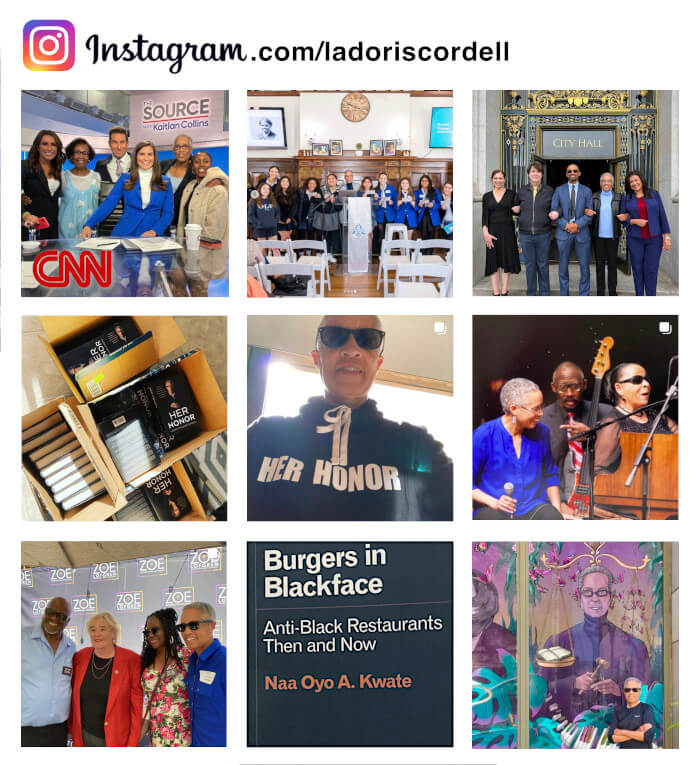Color of Justice
Author: Inez M Robinson-Odom
Publisher: New York, N.Y. : Carousel Film & Video [distributor], ©1990
Edition/Format: VHS video : VHS tape
Summary: The Honorable LaDoris Hazzard Cordell was the first black woman ever to be elected to a Superior Court seat in Northern California. In December of 1988 she attended the first Human Rights Conference ever held in South Africa. This is the story of her journey, her impressions of life in South Africa, told by herself against the background of incidents from her own life in the United States.
March 27, 1992: LA Times article re Color of Justice
SAN DIEGO — In the credits of her award-winning short video, “Color of Justice,” Inez Robinson thanks the producers of “Eyes on the Prize,” the groundbreaking documentary on the American civil rights movement, and calls them “the role models of a lifetime.”
In 1986, a 24-year-old Robinson, uncertain of her future, worked as an administrator on the “Eyes on the Prize” project. It was a seminal experience for a young African-American with thoughts of becoming a filmmaker.
“Here was an African-American producer, working closely with white producers, Asian photographers–a purposeful coming together,” said Robinson, who now is an assistant producer at KPBS-TV (Channel 15).
“Here were people committed to the importance of a story and telling it well.”
“Color of Justice,” which Robinson produced in 1990 while a graduate student at Stanford University, will air on KPBS at 9 tonight, as part of an anthology of Dore Schary Award winners put together by KPBS. The Schary awards program, named after the late filmmaker who produced such classics as “Boys Town” and “Blackboard Jungle,” honors films promoting human dignity and human rights.
In “Color of Justice,” Superior Court Judge LaDoris Cordell, the first black woman to be elected to a Superior Court seat in Northern California, tells about her two-week trip to South Africa to attend a human rights conference. What emerges is something that is far more than a travelogue.
As Cordell recounts her tale, stark parallels between her experiences as a black woman in the United States and those of blacks in South Africa become apparent. Recent events in South Africa, which have signaled the end of apartheid, only make the film more poignant as it vividly illustrates, through one woman’s experiences, the differences between institutionalized racism and the more subtle societal racism that continues to exist in the United States.
Beyond the awards and honors the film has earned Robinson, the work clearly symbolizes the genesis of a filmmaker who wants to do more than TV sitcoms or popular movies. She describes herself as “politically conscious,” and she hopes to interact with the community through her work.
“You can’t be a thinking person today and not be concerned with the state of the world,” she said recently while eating a burrito at a small restaurant near the San Diego State University campus, where KPBS is based.
In the KPBS Office of Public Affairs and Ethnic Issues, Robinson has found a perfect outlet for her social concerns. In the year and four months that she has been at KPBS, she has helped produce “The Only Hope,” a studio-based show about the need for more African-American organ donors; “1492 Revisited,” an examination of Columbus’ exploration of the Americas, and, most recently, a program about multicultural education in San Diego City Schools, which will air in the fall. She also works with a wide variety of community organizations, including Sushi, the African American Donor Task Force in Northern California and the local Institute for Arts Education.
“There are an increasingly large number of young people in the media who have strong interest . . . in the (documentary) form and social issues in general,” said KPBS executive producer Paul Espinosa. “She’s a great example of that.”
Robinson, 29, was working as an independent producer in Northern California when she applied for the KPBS job. “Color of Justice” was a dramatic entry on her resume, “an interesting premise,” Espinosa said.
In addition to serving as her master’s thesis and winning the Schary award, “Color of Justice” has aired on public television in San Francisco and received widespread release through a company specializing in education videos. It has aired in Czechoslovakia and Germany, but this will be its first airing in San Diego.
Robinson met Judge Cordell at a social occasion in 1988, a few days before Cordell was scheduled to leave for South Africa. When she returned, Robinson videotaped an extemporaneous discussion of her trip, which led directly to “Color of Justice.”
“She’s quite good at pulling from people what she needs to get,” Cordell said from Palo Alto. “God, she worked hard.”
Most impressive to Cordell was Robinson’s ability to get funding for the project and see it through. The film cost about $8,000 to produce, $2,500 of which came from the San Francisco-based Gerbode Foundation. Cordell calls Robinson “very stubborn and persistent.”
Cordell’s forceful, unscripted narration is the star of “Color of Justice,” her ability to vividly describe events of her trip and the South African townships she visited during her trip.
“I see ‘Color’ as a chance to show kids a role model, to show kids a woman who is thinking, independent and involved, who happens to be an African-American woman,” Robinson said.
It would have been “presumptuous” to attempt to make a documentary on South Africa, she said. Instead, she focused solely on one woman’s viewpoint–Cordell’s.

